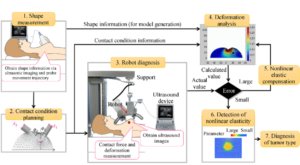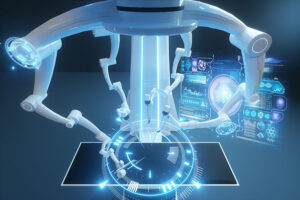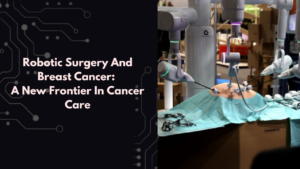Introduction:
Breast cancer is a pervasive and challenging disease, affecting millions of women worldwide. Traditional methods of detection, diagnosis, and treatment have made significant strides, but they often involve invasive procedures and prolonged recovery times. Enter robotic technology—a game-changer in the field of oncology. By integrating robotics into breast cancer care, we are witnessing a revolution that promises enhanced precision, reduced invasiveness, and improved patient outcomes. Let’s explore how robotic technology is transforming breast cancer care.
While advancements in detection and treatment have improved survival rates, there is always room for innovation. Robotic technology, once confined to industries like manufacturing and surgery, is now making its mark in the realm of breast cancer care.
The Role of Robotics in Breast Cancer Detection and Diagnosis:
Robotic technology is revolutionizing breast cancer detection and diagnosis by offering enhanced precision, efficiency, and patient comfort. Here’s how robotics is reshaping this critical aspect of breast cancer care:

- Enhanced Imaging Techniques:
Robotic-Assisted Ultrasound: Robotic systems can perform ultrasound scans with high precision, ensuring consistent and detailed imaging. These systems can also integrate with AI algorithms to enhance the detection of anomalies.
Automated Biopsies: Robotic technology can perform minimally invasive biopsies, guided by advanced imaging, to obtain tissue samples with higher accuracy and less discomfort for patients.
- Advanced Diagnostic Tools:
AI-Powered Analysis: Robotic systems equipped with AI can analyze imaging data in real-time, identifying potential cancerous lesions with greater accuracy than traditional methods. This integration helps in early detection, which is crucial for successful treatment.
Real-Time Feedback: Robotic systems can provide real-time feedback during imaging and biopsy procedures, allowing healthcare providers to adjust their approach as needed. This immediate feedback enhances the quality of diagnosis and ensures optimal outcomes for patients.
Improved Patient Experience: By offering less invasive and more comfortable procedures, robotic technology enhances the overall patient experience during breast cancer detection and diagnosis. Patients may experience less pain, shorter recovery times, and reduced anxiety compared to traditional diagnostic methods.
Innovations in Robotic Surgery:
Robotic technology is revolutionizing breast cancer detection and diagnosis by offering enhanced precision, efficiency, and patient comfort. Here’s how robotics is reshaping this critical aspect of breast cancer care:

Robotic Mastectomy and Lumpectomy: Robotic systems enable surgeons to perform mastectomies and lumpectomies with unparalleled precision and control. The use of robotic arms allows for smaller incisions, reduced trauma to surrounding tissues, and improved cosmetic outcomes compared to traditional open surgery.
Sentinel Lymph Node Biopsy: Robotic-assisted techniques can be utilized to perform sentinel lymph node biopsy, a critical procedure in staging breast cancer. By accurately identifying and sampling sentinel lymph nodes, robotic systems help determine the extent of cancer spread while minimizing the risk of complications.
Da Vinci Surgical System: The Da Vinci Surgical System is one of the most widely used robotic platforms in breast cancer surgery. This system features robotic arms equipped with specialized instruments and a high-definition 3D camera, allowing surgeons to perform complex procedures with enhanced dexterity and visualization.
Precise Tumor Resection: Robotic technology enables precise tumor resection, ensuring complete removal of cancerous tissue while preserving healthy breast tissue. This precision reduces the likelihood of tumor recurrence and the need for additional surgeries, leading to better long-term outcomes for patients.
Enhanced Ergonomics and Comfort: Robotic systems offer ergonomic benefits for surgeons, allowing them to operate with greater comfort and precision over long durations. The intuitive controls and magnified visualization provided by robotic platforms contribute to reduced surgeon fatigue and improved procedural efficiency.
Post-Operative Care and Recovery:
Post-operative care and recovery are crucial aspects of breast cancer treatment, and robotic technology plays a significant role in enhancing patient outcomes and comfort during this phase. Here’s how robotic technology contributes to post-operative care and recovery in breast cancer patients:

Robotic Rehabilitation Assistance: Robotic-assisted devices are used in physical therapy and rehabilitation programs to aid breast cancer patients in regaining strength, mobility, and range of motion following surgery.
Pain Management: Robotic technology can assist in pain management strategies for breast cancer patients post-surgery. This may include the use of robotic devices for precise delivery of pain-relieving medications or techniques such as transcutaneous electrical nerve stimulation (TENS) therapy to alleviate discomfort and promote healing.
Wound Monitoring and Management: Robotic systems equipped with imaging capabilities can monitor surgical incisions and wound healing progress in real-time. This enables healthcare providers to detect any signs of infection or complications early and take prompt action to address them.
Remote Monitoring and Telemedicine: Some robotic platforms offer telemedicine capabilities, allowing healthcare providers to remotely monitor patients’ recovery progress and address any concerns or questions they may have.
Patient Education and Support: Robotic technology can facilitate patient education and support initiatives during the recovery phase. Interactive robotic interfaces or virtual reality platforms may be used to provide patients with educational resources, rehabilitation exercises, and emotional support, empowering them to actively participate in their recovery journey.
Future Directions in Robotic Breast Cancer Care:
Future directions in robotic breast cancer care are poised to further revolutionize the field, offering innovative solutions to improve outcomes, enhance patient experiences, and advance the standard of care. Here are some key areas of development and potential advancements:

Predictive Analytics: Combining robotic technology with AI can predict patient outcomes and personalize treatment plans based on individual data, leading to more effective and tailored care.
Continuous Monitoring: Wearable robotic devices can continuously monitor vital signs and detect early signs of complications, enabling timely interventions.
Telemedicine and Remote Surgery:
Remote Consultations: Robotic systems equipped with telemedicine capabilities allow specialists to consult and diagnose patients remotely, increasing access to expert care, especially in underserved areas.
Telerobotic Surgery: Surgeons can perform procedures remotely using robotic systems, providing high-quality care to patients regardless of geographical barriers.
Conclusion:
The rise of robotic technology in breast cancer care represents a monumental shift towards more precise, less invasive, and highly personalized treatment options. By enhancing detection, diagnosis, surgery, and recovery processes, robotic technology is not only improving patient outcomes but also transforming the entire landscape of breast cancer care. As innovation continues to advance, the integration of robotics, AI, and machine learning promises an even brighter future for patients battling breast cancer, offering hope and healing through cutting-edge technology.

